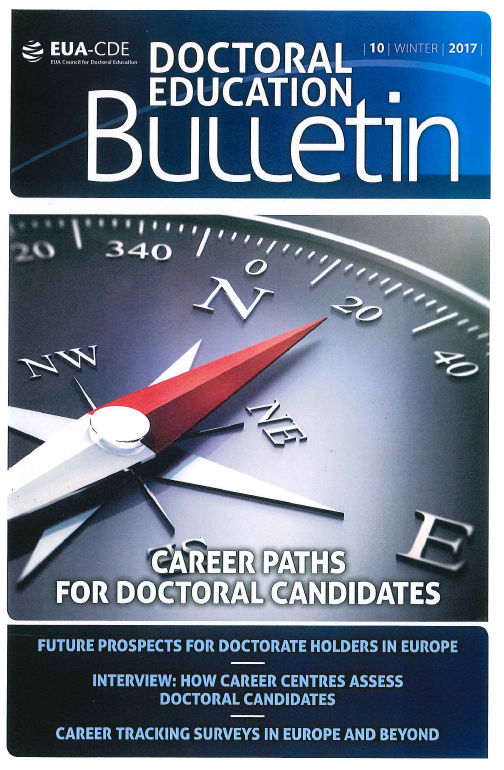BACK TO RESEARCH WITH IMPACT: FNR HIGHLIGHTS
BACK TO RESEARCH WITH IMPACT: FNR HIGHLIGHTS
Universities train tomorrow’s highly skilled workforce. Many students and researchers will work in jobs outside academia that currently do not even exist. It is therefore important that they have a notion of other sectors and that their training equips them with flexible skills. In a contribution for the latest EUA-CDE Doctoral Education bulletin, Ulrike Kohl, Head of Talent Attraction and Capacity Building at the FNR, explains that intersectoral mobility is a way to stimulate such flexibility and one that can take a variety of forms.
It is difficult to know how many researchers are mobile between sectors in Europe. One of the few data sources in this regard has been the EU’s MORE2 Study. According to the results published in 2013, only 12% of the respondents from academia had been intersectorally mobile to the private industry[1]. In July 2017, the EU launched a survey to collect more recent data.

Stimulating intersectoral mobility of researchers becoming more of a priority
Stimulating intersectoral mobility of researchers has become one of the priorities of the ERA and the Innovation Union. In the monitoring of the Lisbon strategy, the EU published a report in 2006 with twelve key recommendations to promote intersectoral mobility of researchers, a report that is still very relevant[2].
The EUA Doc Careers Projects I and II[3] carried out between 2006 and 2012 in different European regions found that successful intersectoral mobility depended on an environment of trust through long-term relationships at regional level between higher education and industry.
At the level of Science Europe[4], an umbrella organisation of research funders and research performing organisations in Europe, a survey was carried out in 2015 to assess existing support measures for intersectoral mobility[5]. The findings suggested that few member organisations considered intersectoral mobility as a strategic priority in 2015, but that there was a trend towards an increase in the number of support schemes and the strategic relevance of the topic in the future.
The EU’s Steering Group on Human Resources[6] published a report in 2016, where main obstacles to researchers’ intersectoral mobility were identified. A lack of R&D development in certain European regions, legal and administrative barriers, the absence of appropriate IPR frameworks, and a lack of business relevant skills among researchers were identified as some of the key obstacles. On the other hand, industry was keen to collaborate with academia to gain access to talent and early research results.
Intersectoral mobility in research does not happen alone, in particular due to cultural gaps between sectors. It needs specific promotion. Academia and business should collaborate to develop frameworks and opportunities for intersectoral mobility available to researchers at all career levels with appropriate funding and training. The Luxembourg National Research Fund (FNR) has introduced a series of tailor made schemes since 2014 that successfully promote intersectoral mobility of researchers[7].
However, there is no unanimous support for this type of measure. There is also a justified concern that promoting intersectoral collaboration might increase the pressure on higher education institutions to become more commercial.
Umbrella organisations such as EUA can play a role to ensure that opening up collaborations with industry does not compromise the original role of universities as knowledge institutions. Both sectors are complementary and should be enabled to use their strengths: academic institutions to develop new fundamental knowledge and the business sector to transfer research results into marketable products and services.
This article was originally published in the EUA-CDE Doctoral Education Bulletin, Winter 2017/18 issue on the topic ‘Career Paths for Doctoral Candidates‘
[1] http://ec.europa.eu/euraxess/pdf/research_policies/more2/Final%20report.pdf
[2] https://cdn5.euraxess.org/sites/default/files/policy_library/mobility_of_researchers_light.pdf
[3] http://www.eua.be/activities-services/projects/past-projects/research-and-innovation/doc-careers-ii.aspx
[5] https://www.scienceeurope.org/wp-content/uploads/2017/01/SE_Intersec-Mobility_Survey_Report.pdf
[6] https://cdn2.euraxess.org/sites/default/files/policy_library/final_report_sghrm_intersectoral_mobility_final_report_0.pdf
[7] Details available at www.fnr.lu/innovation-industry-partnerships/
OTHER OPINION PIECES


RELATED PROGRAMMES